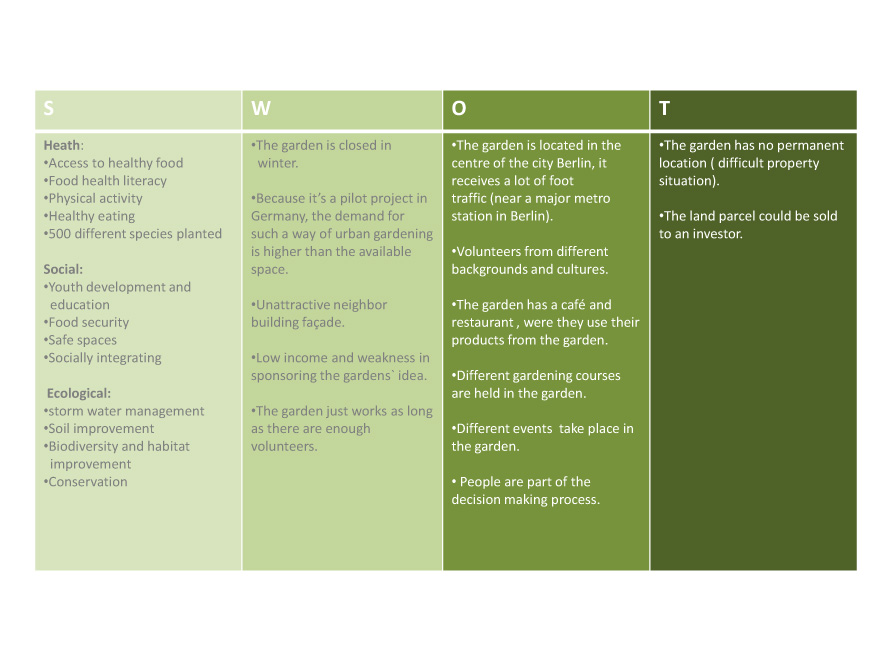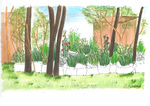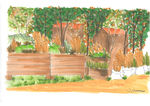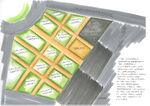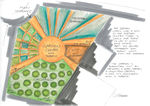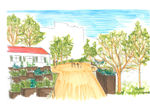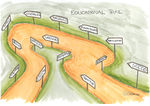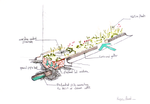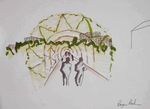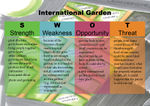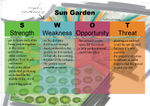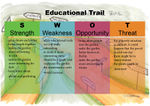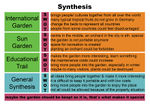Collaborative Design Planting Design Working Group 12: Difference between revisions
| (14 intermediate revisions by 2 users not shown) | |||
| Line 35: | Line 35: | ||
Prinzessinnengärten is an example of social and ecological urban agriculture; which plays a key role in two challenges: urbanization and food security. It can provide an important contribution to sustainable, resilient urban development, creation and maintenance of multifunctional urban landscapes. | |||
The idea of | The idea of Prinzessinnengärten came from Robert Shaw, who spent several years in Cuba, and by accident he saw people using urban wastelands to produce local food, those waste lands were given by the city to the people in different places to use them for cultivation. Beside growing vegetables and crops, they also have created places within the gardens where people could meet to socialize and learn from each other. | ||
After he returned back to Germany he told his friend Marco Clausen about his experience there. Although they were far from their original professions: Robert is a film maker and Marco studied history and had some experience in bars, together they developed the idea of a kitchen garden in Berlin in 2009. At the beginning it was not easy to find a piece of wasteland in the middle of the city Berlin for farming purposes and especially not for a long period of time. Therefore, they rented a piece of land and use it as long as they can, but they had to create a system that's able to move( Mobile Farm ). Plastic crates and rice bags were chosen for their new mobile system, and those two objects were suitable for the nomadic green feature, to easily transport them when they need to move to another place. | After he returned back to Germany he told his friend Marco Clausen about his experience there. Although they were far from their original professions: Robert is a film maker and Marco studied history and had some experience in bars, together they developed the idea of a kitchen garden in Berlin in 2009. At the beginning it was not easy to find a piece of wasteland in the middle of the city Berlin for farming purposes and especially not for a long period of time. Therefore, they rented a piece of land and use it as long as they can, but they had to create a system that's able to move( Mobile Farm ). Plastic crates and rice bags were chosen for their new mobile system, and those two objects were suitable for the nomadic green feature, to easily transport them when they need to move to another place. | ||
The Prinzessinnengarten is located at the Moritzplatz in Berlin; a busy roundabout in the center of bustling Kreuzberg; it’s a public property of an almost 6000 square feet area. In summer of 2009, the two founders rented this piece of land from the Real Estate Fund Berlin. Over a thousand supporters have helped the site to grow from an vacant lot to a green open space. Without previous expertise, with little money and armed with the idea of communally used garden in the center of the city, inspired by a trip to Cuba, they began to send down the first roots of a flourishing garden between cement and rubble. About 500 different types of herbs and vegetables are growing here. A diversity of plants is growing here as well as a diversity of social relations. People of different origins and of different ages meet and exchange their knowledge and their experience. | The Prinzessinnengarten is located at the Moritzplatz in Berlin; a busy roundabout in the center of bustling Kreuzberg; it’s a public property of an almost 6000 square feet area. In summer of 2009, the two founders rented this piece of land from the Real Estate Fund Berlin. Over a thousand supporters have helped the site to grow from an vacant lot to a green open space. Without previous expertise, with little money and armed with the idea of communally used garden in the center of the city, inspired by a trip to Cuba, they began to send down the first roots of a flourishing garden between cement and rubble. About 500 different types of herbs and vegetables are growing here. A diversity of plants is growing here as well as a diversity of social relations. People of different origins and of different ages meet and exchange their knowledge and their experience. | ||
Their goal is to create a place of exchange and learning on issues of local and organic cultivation of food, biodiversity, sustainable consumption, the responsible use of resources and a sustainable neighborhood and urban development. | Their goal is to create a place of exchange and learning on issues of local and organic cultivation of food, biodiversity, sustainable consumption, the responsible use of resources and a sustainable neighborhood and urban development. | ||
The garden has a | The garden has a café and a restaurant that help to fund the project, also seedlings are sold in modified Tetra Paks from a shipping container that has been converted into a sales stall. | ||
| Line 60: | Line 60: | ||
-Signboard announces days when visitors can work in the garden. | -Signboard announces days when visitors can work in the garden. | ||
Income is generated through the | '''How they fund the garden?''' | ||
Income is generated through the gardens´ restaurant and café, selling vegetables, in addition to funds that they acquire for the implementation of various educational projects, from the construction of other gardens, consulting services, fees for images (Garden postcards), presentations and guided tours, as well as donations in form of planter and garden sponsorships. | |||
[[File:SOWT-GARTEN15.jpg]] | [[File:SOWT-GARTEN15.jpg]] | ||
| Line 133: | Line 134: | ||
Image:vegitation-urban agriculture.jpg|vegetation | Image:vegitation-urban agriculture.jpg|vegetation | ||
Image:Circulation-urban agriculture.jpg|circulation | Image:Circulation-urban agriculture.jpg|circulation | ||
Image:prinzessinnengaden2009-2012.jpg|before and after | |||
</gallery> | </gallery> | ||
| Line 145: | Line 147: | ||
Image:drainage01_web.png|Slope in land | Image:drainage01_web.png|Slope in land | ||
Image:drainage02_web.png|bioswale design | Image:drainage02_web.png|bioswale design | ||
Image:connecting.jpg|connecting public spases | |||
Image:bridge vision1.jpg|bridge | |||
</gallery> | </gallery> | ||
| Line 184: | Line 190: | ||
Image:prinz10.jpg|image 8 | Image:prinz10.jpg|image 8 | ||
</gallery> | </gallery> | ||
== References == | == References == | ||
http://prinzessinnengarten.net/ | |||
http://prinzessinnengarten.net/about/ | |||
http://prinzessinnengarten.net/ | |||
Latest revision as of 14:37, 29 January 2014
---> back to group page working group 12
The `Prinzessinnengärten` in Berlin as example for Community Gardening
| Name | Prinzessinnengärten | |
| Location | Berlin | |
| Country | Germany | |
| Authors | Dorothea Eisenmann, Razan Alsoud | |
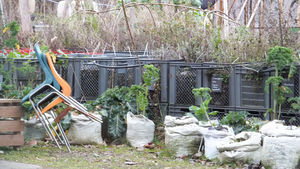
| ||
|
| ||
Landscape and/or urban context of your case
Prinzessinnengärten is an example of social and ecological urban agriculture; which plays a key role in two challenges: urbanization and food security. It can provide an important contribution to sustainable, resilient urban development, creation and maintenance of multifunctional urban landscapes.
The idea of Prinzessinnengärten came from Robert Shaw, who spent several years in Cuba, and by accident he saw people using urban wastelands to produce local food, those waste lands were given by the city to the people in different places to use them for cultivation. Beside growing vegetables and crops, they also have created places within the gardens where people could meet to socialize and learn from each other. After he returned back to Germany he told his friend Marco Clausen about his experience there. Although they were far from their original professions: Robert is a film maker and Marco studied history and had some experience in bars, together they developed the idea of a kitchen garden in Berlin in 2009. At the beginning it was not easy to find a piece of wasteland in the middle of the city Berlin for farming purposes and especially not for a long period of time. Therefore, they rented a piece of land and use it as long as they can, but they had to create a system that's able to move( Mobile Farm ). Plastic crates and rice bags were chosen for their new mobile system, and those two objects were suitable for the nomadic green feature, to easily transport them when they need to move to another place.
The Prinzessinnengarten is located at the Moritzplatz in Berlin; a busy roundabout in the center of bustling Kreuzberg; it’s a public property of an almost 6000 square feet area. In summer of 2009, the two founders rented this piece of land from the Real Estate Fund Berlin. Over a thousand supporters have helped the site to grow from an vacant lot to a green open space. Without previous expertise, with little money and armed with the idea of communally used garden in the center of the city, inspired by a trip to Cuba, they began to send down the first roots of a flourishing garden between cement and rubble. About 500 different types of herbs and vegetables are growing here. A diversity of plants is growing here as well as a diversity of social relations. People of different origins and of different ages meet and exchange their knowledge and their experience. Their goal is to create a place of exchange and learning on issues of local and organic cultivation of food, biodiversity, sustainable consumption, the responsible use of resources and a sustainable neighborhood and urban development. The garden has a café and a restaurant that help to fund the project, also seedlings are sold in modified Tetra Paks from a shipping container that has been converted into a sales stall.
Plants in the garden:
turnips, carrots, parsnips, kale, red Russian kale, radishes, fennel, basil, tarragon, sage, thyme, lovage, salad burnet, sorrel, chard, orache, charlock mustard and purslane.
luminescent blossoms of dandelion, cornflower, nasturtium, borage and malva.
Growing in rice sacks are different varieties of potatoes with revolutionary or royal names like Red Emma and King Edward.
Signs are used for:
-Signboard indicates which vegetables are ripe enough for visitors to harvest themselves.
-Signboard announces days when visitors can work in the garden.
How they fund the garden?
Income is generated through the gardens´ restaurant and café, selling vegetables, in addition to funds that they acquire for the implementation of various educational projects, from the construction of other gardens, consulting services, fees for images (Garden postcards), presentations and guided tours, as well as donations in form of planter and garden sponsorships.
What are the objectives of your design?
The garden create a space for everyone to be a gardener. It is a social, ecological urban agriculture. It is a place to spend time, learn from each other and get in contact with nature and other people. Aims are to learn everything from the very beginning. How to get seeds? How to seed and plant? How to pick? And how to handle the products? Everyone can share his or her experiences or just try something new. Together it is possible to learn more about biodiversity, urban ecology, climate change, recycling and sustainable consumption.
Our objectives:
- analyse the existing
- get to know the cultural and the urban context
- improve the current situation
- improve its weaknesses
- make the garden active in winter (because at the moment it is closed during this season)
- make the garden more educational
- create an interactive space
- find ways to make it even more popular than it is already
- create a bigger green space (green bridges)
How could we make the garden function during winter?
Keeping the garden open during winter time, through selecting the right crops to grow, and that improve the way scheduled for planting & harvesting.
- Increase the productivity of the garden
- Get people outside in the fresh air
- Allow to exercise and can give a brilliant grown production to the garden even in winter season.
Sowing seeds in covered containers, the containers act as mini greenhouses, allowing the seeds to experience the chill of winter in a controlled environment.
Choose seeds that are hard; Seeds of tropical and tender plants will die in the cold.
Some good choices for winter sowing:
• Flowers: Alyssum, Butterfly Weed, Calendula, Coreopsis, Cosmos, Foxgloves, Hollyhocks, Petunias
• Vegetables: Beets, Broccoli, Cabbage, Chard, Carrots, Kale, Mache, Radishes, Spinach
New methods useful for the mobile system in the garden:
1. Winter container gardening
2. Sub-irrigation
3. Sub-irrigated rain gutter
Analytical drawings
Please add four analytical sketches/drawings (or montages/schemes) of your case. Every group member needs to contribute at least one drawing.
- Analytical Drawings
Projective drawings
Please add four projective sketches/drawings (or montages/schemes), of course with an emphasis on planting design/vegetation aspects. Every group member needs to contribute at least one drawing representing his/her individual ideas.
- Projective Drawings
Design Synthesis
Please analyse the individual approaches presented so far and evaluate their strengths and weaknesses (you may use the SWOTanalysis model). Try to create a synthesis and represent it with a plan and some sketches. You can still use drawings/sketches.
- Design Synthesis Drawings
Summary of the collaborative process
About working on the case
It was quite interesting to learn more about Urban Gardening, especially about the Prinzessinengärten in Berlin and the idea of this project. While studying the case we got to know new methods and techniques in gardening. We also learned more about connecting people and cultures and how amazing it is to establish such a project with volunteers.
We tried to find ideas how to improve its weaknesses and make it more likely, but we also have in mind that nobody knows how long this garden will exist (because of the difficult property situation). That’s the reason why many ideas are nice but maybe not practical.
To come to a conclusion: perhaps the garden works that good because of the fact, that it is as it is. Maybe another reason for its success is the allure that nobody knows how long it will be possible to use the garden. Or it is just famous because it is something new?? So it could be the best to keep the garden up as it is and look with suspense to the future.
About working collaborative
At the beginning it was a challenge to find a case to work on, with the fact in mind, that one person knows the place already and the other person (maybe) has never heard of it before. So it is more difficult for one person to get to know the case and to work on it than for the other person. During the process it was a nice experience to work together on one case. Especially because of the fact, that each group member has different backgrounds. We both come, of course, from different countries (Jordan and Germany) but we also have different learned professions: one architect and one landscape architect. It has been interesting to see two different ways of analyzing a context and getting into the case. But we also realized that we both have some common ways of studying a case. We both analyze for example, what exists and what has to be improved. There are the same approaches in both subjects. The main problem what made the collaborative work tricky is the fact, that everything we had to discuss and talk about was discussed via Skype. Skype is a nice opportunity to talk to each other but it can’t replace the work face to face.
Image Gallery
- Image Gallery
References
http://prinzessinnengarten.net/
http://prinzessinnengarten.net/about/
About categories: You can add more categories with this tag: "", add your categories
